
Have you ever thrown a shopping cart out of a convertible at 80 mph to observe the sparks? How about hooking up a power amplifier to 115 volts AC just to see how it craters? Your fellow engineers have done these things and more! If you have a great picture of totally destroyed hardware, or a photo of a blown circuit, send it to us! If it gets on the web site you will receive a free Microwaves101 key chain pocket knife! Impress your friends, if not your boss!
Note to mortuary contributors: please consider that your boss may not find your submission in the best interests of your Big Company. Lately we've been getting a lot of "please remove my submission" emails, try not to send us anything that you might regret.
Note to Big Companies: Don't blame us for posting your spectacular failures, we only post what your employees send us. On the other hand, please don't rip off Microwaves101 pictures for presentations without permission, that's bad manners. Maybe it's time for some training!
Note to mortuary fans: We put new stuff here at the top, but older disasters are still here too--just scroll down.In many cases, if you click on pictures on this page you can see higher resolution images.
This came from Daniel:
I have an exhibit for the Microwave Mortuary. It's an AC input filter (220 volts) from a 300W Ku-band amplifier. The power connector turned out not as weatherproof as it claimed to be, so some rain water got inside and turned most of the filter into smoke, tar and charcoal.
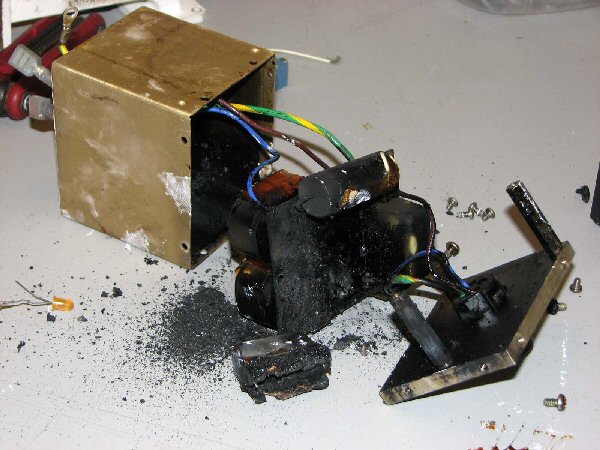
Let me guess... removing screws voids the manufacturer's warrantee! - UE
These two video links came from Isaac:
I see this kind of work a lot, but this takes the cake. This is an $18,000 radio someone put up with zip ties and bailing wire. Makes me wonder why they are always having trouble with this path.
Ever get mad at your test equipment and wish you could do this with it??
These photos also came from Ben:
There are lots of different antennas on the market for different applications ranging from simple Hertzian dipole, patch, Yagi, horn to expensive dish antennas. They can be made of a simple cable, build on a PCB, or even integrated on silicon.
We found a versatile antenna with reasonable efficiency and very low cost. The antenna was not found by 3D EM simulation or theoretical calculations, but by research in the field. We don't know the directional reception pattern yet, but we still are doing research on this topic. We called it the fork antenna, simply by its shape. I discovered it in Gori, Georgia, Central Asia. I actually don't know how it really works, but this is no fake, I watched television on this TV set with this antenna. Maybe somebody could check in the US if this type of antenna also works with the new digital TV.
This photo came from Ben from Deutschland, who is becoming a regular contributor!
Hey, I killed a chip and made a photo of it. The chip is die and wire bonded to a PCB, some bondwires are gone because the board was on my desk for half a year and didn't work anymore. The photo was made with a Nokia Handycamera through a microscope, the quality is really good for that. What happened to the chip?
I designed a circuit including an amplifier and wanted to control the biasing current, which is a frequent concern in RFIC research. I made two current input pins. In the lab, I turned off my setup, the supply voltage and RF sources. But I forgot to turn off the current sources. When pulling the current plugs, the current source went to the voltage limit. Unfortunately this was 40V, a bad idea for an IC. The ESD protection and a part of the circuit exploded (I even could see a flash) and melted (both marked in red). The fallout is distributed all over the chip. So be advised: Never use current input if you want to tweak your biasing current. Always use voltage input biasing control pins!
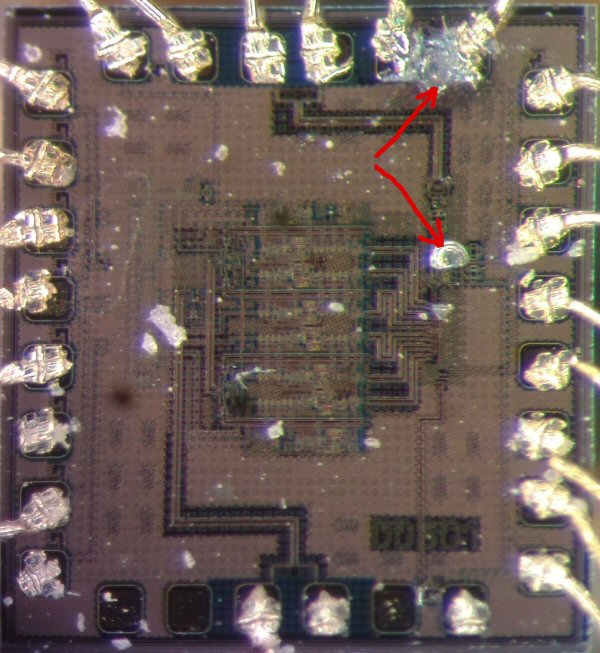
This picture came from Paul:
We had a path fading. No foul weather and we couldn't see a problem with the antenna or feed horn from the ground with your binoculars. See what we found on the feed horn when we had the cable crew closely inspect this feed horn. You had to get to within five feet before the corrosion was apparent. The pressure of the corrosion pushed the brass in till there was a short from side to side. Salt air, this was 100 yds from the ocean.
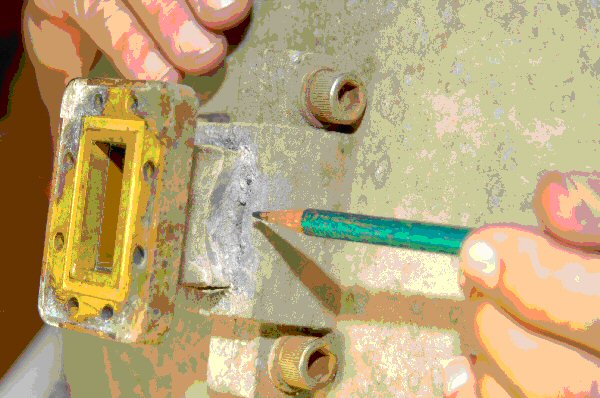
This picture came from Benjamin from Slovenia. This is an example of what happens when you short out 230 volts at 60 amps.... yikes!
We accidentally connected the switch so it made a short when switched to ON. You wouldn't like to be there when it happened... We had a New Year's Eve. My co-worker (he switched it on) got minor burns and luckily that was everything.
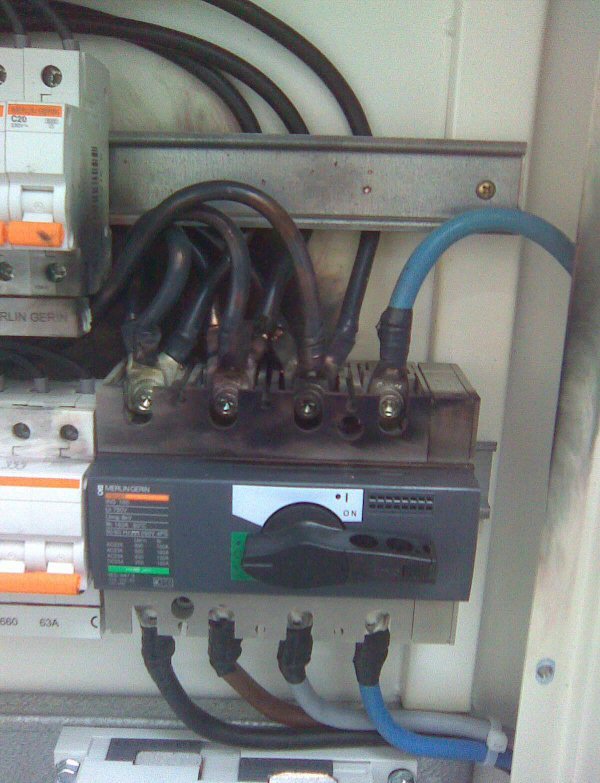
This photo came from Ben from Deutschland, who also provided us some advice on microwave career killers:
I've got something for the microwave mortuary. It's not so much microwave, but more power supply related.
What to do if your power cord is broken? Replace it? Not necessarily! Just cut the connector, skin the wires, plug them into the socket and fix it with the connector. Maybe you have to turn the power off before you plug the wires in! I think you also should not touch the top of the connector.
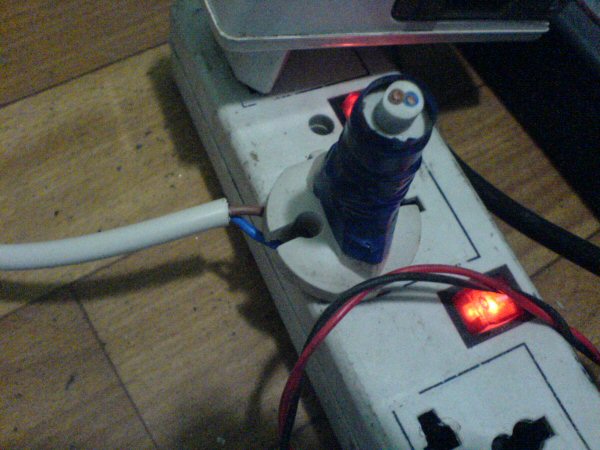
That's sage advice, especially when you consider that this is a European outlet providing 240 volts. Thanks, Ben!
This picture came from Paul, showing the remains of a beefy amplifier. Thanks!
This is (what's left of) the input power filter network in a Techron 3020 300V, 200A power amplifier for a MRI system - one of a 3-channel set. All three channels were fed from a common DC rail fed by a full-wave rectifier directly from a 3-phase AC supply. Since it's a pulse amplifier with quite a lot of electrolytics, there's plenty of reserve to draw from. The only circuit protection was the panel breaker. This channel blew up with a shotgun-like blast when one of its output MOSFET modules shorted. The module itself disappeared into plasma, along with a good chunk of its heatsink structure. The date? 9/9/99. I shoulda guessed something bad was going to happen. We never did find the root cause, but figure it must have been poor heatsinking and device overheating. We ran these right at the hairy edge, so didn't even attempt a repair. We replaced them instead with much larger 700V/350A amplifiers.
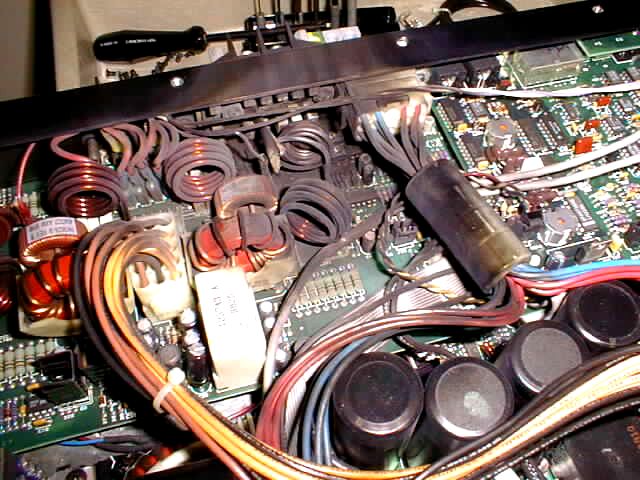
These pix came from Dave from Down Under, where beer does flow and men chunder! Thanks!
Some pix of a CCTV DVR board from a computer. I noticed that several power rail caps on the PC motherboard had also bulged but not blown. I'm not sure if it was the PC power supply that killed the DVR boards or the other way around. Unfortunately I couldn't keep the boards for a memento as the client wanted them for a insurance claim. Both DVR boards had blown in the same place around the V-regulator area.
These images came from "anonymous ham enthusiast" who might have blown his cover as well as his amplifiers. Thanks!
Class C amplifiers and and black powder DO mix!
This is the product of a bet between myself and a radio geek friend of mine. I had an ailing, home-brew, ham fest special, 220 MHz amplifier that had an arcing trimmer cap. After cleaning up some of the "welds," the problem persisted.
To be honest with you, I didn't get much deeper into the troubleshooting process. A fellow radio geek came over and spotted a can of "powder" on my "other" bench. The devil's grin appeared on his face immediately after I told him what I was working on. He bet me that the spark from the cap. wouldn't be enough to trigger the mixture. He was wrong! Enjoy.
Here is a video of an acorn stash, inside a microwave antenna. Anyone know the dielectric constant of acorns? The original non-embeddable ebaumsworld link was sent to us by Kyle, but the youtube link below came from Keith in May 2012. Enjoy!
These photos came from Richard... the picture on the lower right would make a scary computer "desktop", click it twice to see the non-airbrushed details.
| The first picture is a transfer panel that was missing a 4 inch seal which the birds took advantage of. The flood pictures were from this year in Franklin, In. during the great flood of aught8. There was 25 inches of water inside the building and it sits on a 30" high pad. The last and certainly least is one of my fellow technicians when we restored traffic. |
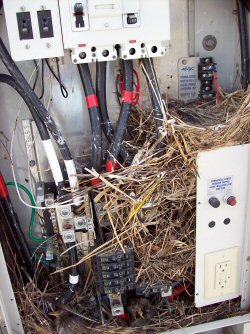 |
This image came from Mike:
You know how the data sheets on TO-case power resistors strongly suggest the use of high quality thermal grease? Ever wonder what happens when your tech doesn't bother? Bustication!
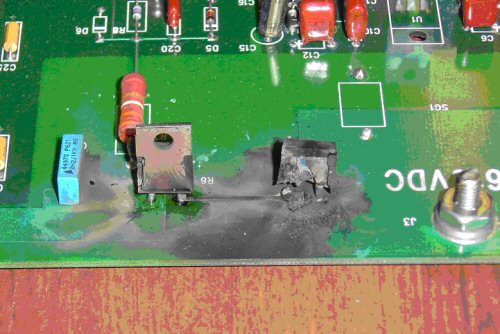
Mike also contributed an example of an unstable amplifier (example #4), thanks Big Guy!